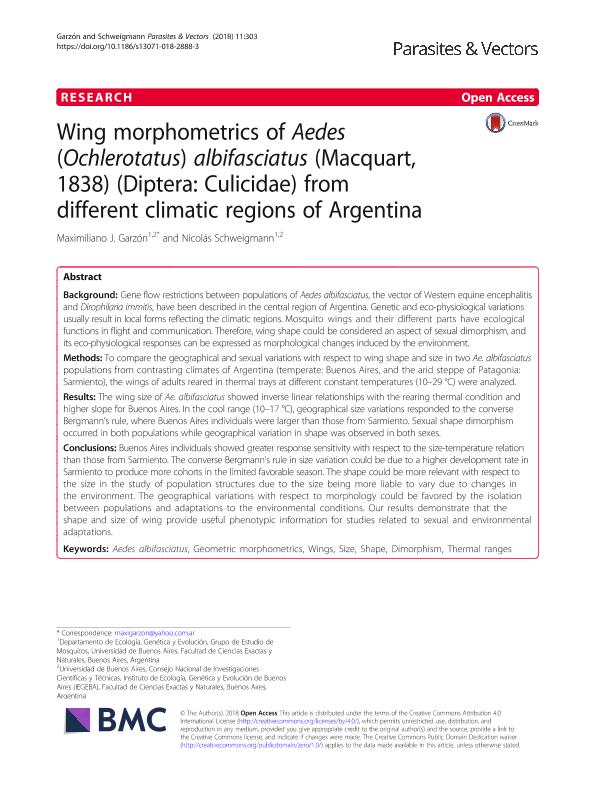Mostrar el registro sencillo del ítem
dc.contributor.author
Garzón, Maximiliano Javier

dc.contributor.author
Schweigmann, Nicolas Joaquin

dc.date.available
2020-02-03T20:51:40Z
dc.date.issued
2018-05
dc.identifier.citation
Garzón, Maximiliano Javier; Schweigmann, Nicolas Joaquin; Wing morphometrics of Aedes (Ochlerotatus) albifasciatus (Macquart, 1838) (Diptera: Culicidae) from different climatic regions of Argentina; BioMed Central; Parasites and Vectors; 11; 1; 5-2018; 1-10
dc.identifier.issn
1756-3305
dc.identifier.uri
http://hdl.handle.net/11336/96622
dc.description.abstract
Background: Gene flow restrictions between populations of Aedes albifasciatus, the vector of Western equine encephalitis and Dirophilaria immitis, have been described in the central region of Argentina. Genetic and eco-physiological variations usually result in local forms reflecting the climatic regions. Mosquito wings and their different parts have ecological functions in flight and communication. Therefore, wing shape could be considered an aspect of sexual dimorphism, and its eco-physiological responses can be expressed as morphological changes induced by the environment. Methods: To compare the geographical and sexual variations with respect to wing shape and size in two Ae. albifasciatus populations from contrasting climates of Argentina (temperate: Buenos Aires, and the arid steppe of Patagonia: Sarmiento), the wings of adults reared in thermal trays at different constant temperatures (10-29 °C) were analyzed. Results: The wing size of Ae. albifasciatus showed inverse linear relationships with the rearing thermal condition and higher slope for Buenos Aires. In the cool range (10-17 °C), geographical size variations responded to the converse Bergmann's rule, where Buenos Aires individuals were larger than those from Sarmiento. Sexual shape dimorphism occurred in both populations while geographical variation in shape was observed in both sexes. Conclusions: Buenos Aires individuals showed greater response sensitivity with respect to the size-temperature relation than those from Sarmiento. The converse Bergmann's rule in size variation could be due to a higher development rate in Sarmiento to produce more cohorts in the limited favorable season. The shape could be more relevant with respect to the size in the study of population structures due to the size being more liable to vary due to changes in the environment. The geographical variations with respect to morphology could be favored by the isolation between populations and adaptations to the environmental conditions. Our results demonstrate that the shape and size of wing provide useful phenotypic information for studies related to sexual and environmental adaptations.
dc.format
application/pdf
dc.language.iso
eng
dc.publisher
BioMed Central

dc.rights
info:eu-repo/semantics/openAccess
dc.rights.uri
https://creativecommons.org/licenses/by-nc-sa/2.5/ar/
dc.subject
AEDES ALBIFASCIATUS
dc.subject
DIMORPHISM
dc.subject
GEOMETRIC MORPHOMETRICS
dc.subject
SHAPE
dc.subject
SIZE
dc.subject
THERMAL RANGES
dc.subject
WINGS
dc.subject.classification
Ecología

dc.subject.classification
Ciencias Biológicas

dc.subject.classification
CIENCIAS NATURALES Y EXACTAS

dc.title
Wing morphometrics of Aedes (Ochlerotatus) albifasciatus (Macquart, 1838) (Diptera: Culicidae) from different climatic regions of Argentina
dc.type
info:eu-repo/semantics/article
dc.type
info:ar-repo/semantics/artículo
dc.type
info:eu-repo/semantics/publishedVersion
dc.date.updated
2019-10-09T20:45:03Z
dc.journal.volume
11
dc.journal.number
1
dc.journal.pagination
1-10
dc.journal.pais
Reino Unido

dc.journal.ciudad
Londres
dc.description.fil
Fil: Garzón, Maximiliano Javier. Consejo Nacional de Investigaciones Científicas y Técnicas. Oficina de Coordinación Administrativa Ciudad Universitaria. Instituto de Ecología, Genética y Evolución de Buenos Aires. Universidad de Buenos Aires. Facultad de Ciencias Exactas y Naturales. Instituto de Ecología, Genética y Evolución de Buenos Aires; Argentina
dc.description.fil
Fil: Schweigmann, Nicolas Joaquin. Consejo Nacional de Investigaciones Científicas y Técnicas. Oficina de Coordinación Administrativa Ciudad Universitaria. Instituto de Ecología, Genética y Evolución de Buenos Aires. Universidad de Buenos Aires. Facultad de Ciencias Exactas y Naturales. Instituto de Ecología, Genética y Evolución de Buenos Aires; Argentina
dc.journal.title
Parasites and Vectors

dc.relation.alternativeid
info:eu-repo/semantics/altIdentifier/doi/https://doi.org/10.1186/s13071-018-2888-3
dc.relation.alternativeid
info:eu-repo/semantics/altIdentifier/url/https://parasitesandvectors.biomedcentral.com/articles/10.1186/s13071-018-2888-3
Archivos asociados
